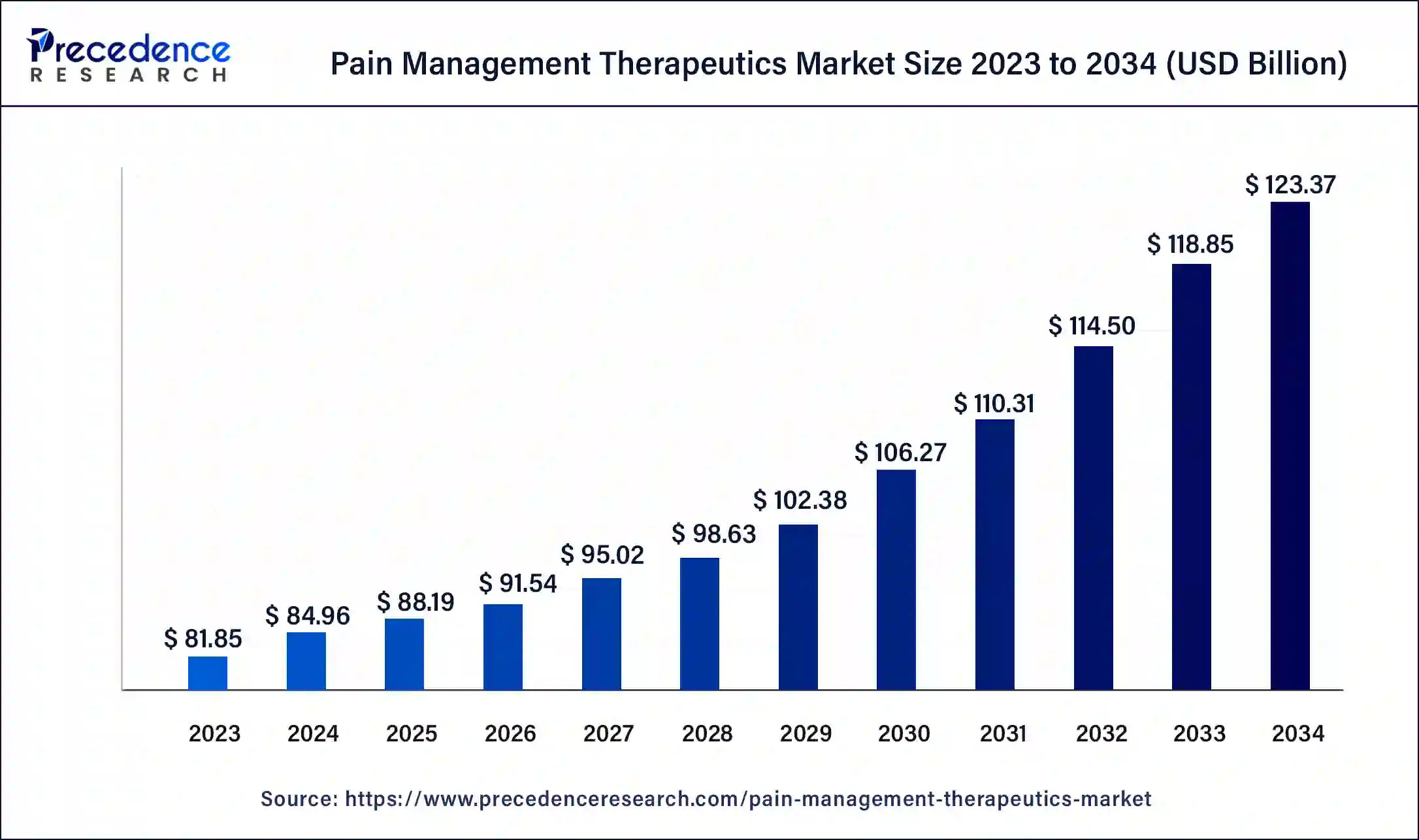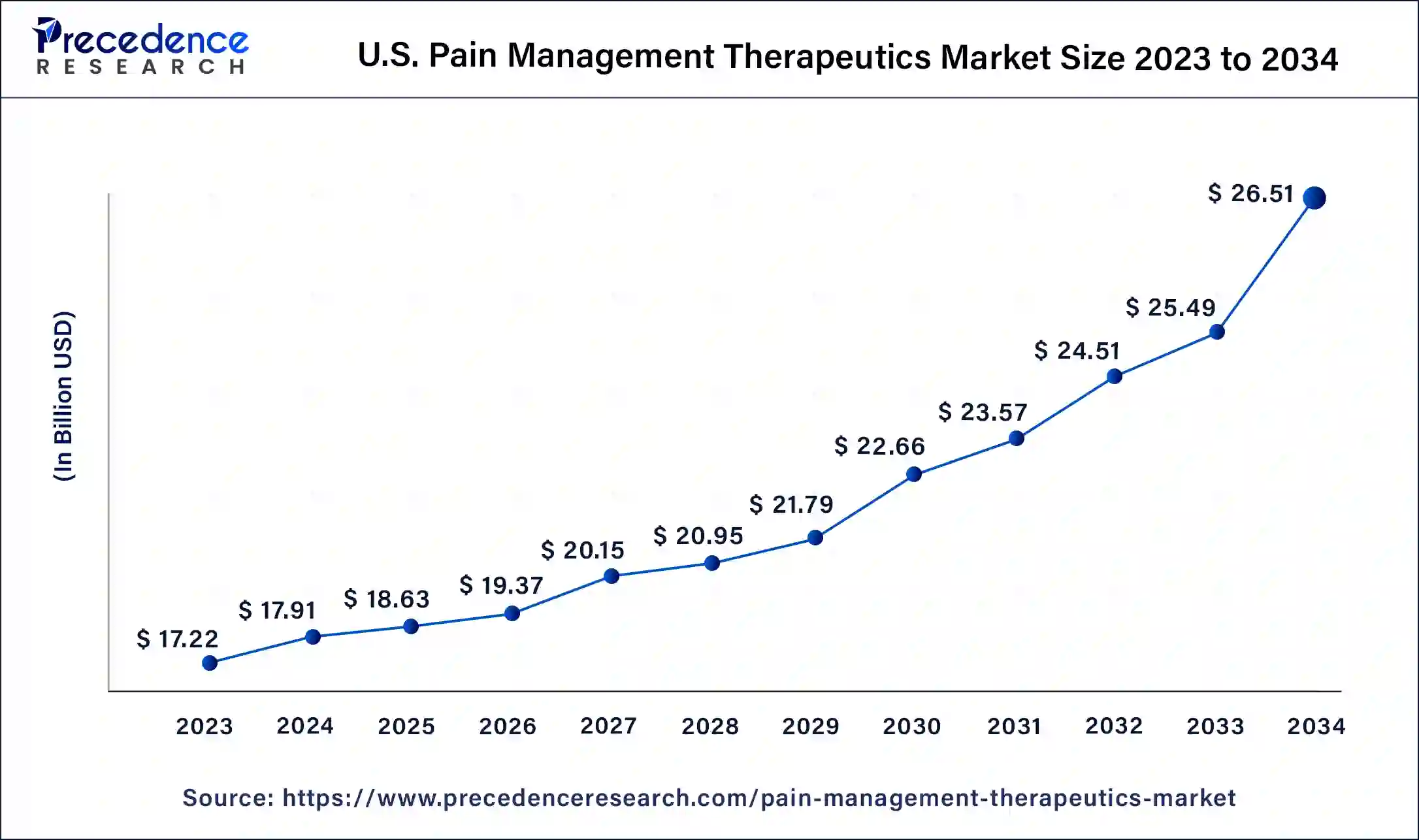October 2024
The global pain management therapeutics market size was USD 81.85 billion in 2023, calculated at USD 84.96 billion in 2024 and is expected to reach around USD 123.37 billion by 2034, expanding at a CAGR of 3.8% from 2024 to 2034.
The global pain management therapeutics market size accounted for USD 84.96 billion in 2024 and is expected to reach around USD 123.37 billion by 2034, expanding at a CAGR of 3.8% from 2024 to 2034. The North America pain management therapeutics market size reached USD 24.56 billion in 2023.

The U.S. pain management therapeutics market size was estimated at USD 17.22 billion in 2023 and is predicted to be worth around USD 26.51 billion by 2034, at a CAGR of 4% from 2024 to 2034.

The research study covers key prospects and trends of pain management therapeutics products throughout different regions including Europe, North America, Asia-Pacific, Middle East and Africa, and Latin America. Regionally, the pain management therapeutics market is dominated by North America due to high incidence of chronic disorders and the presence of skilled researchers. On the other hand, Asia-Pacific is anticipated to witness the rapid growth rate, on account of increasing investment by major manufacturers, increasing cases of accidents, and high production of generics in the region.

According to the data published by National Center for Complementary and Integrative Health, more than 20% of adult population in the United States was suffering from chronic pain and around 8% had severe chronic pain in the year 2018. In multiple studies it has been demonstrated that females are more susceptible to pain as compared to males. Almost 27% of women suffer from pain whereas around 24% of men undergo pain in the United States. Doctors generally prescribe Non-steroidal anti-inflammatory drugs (NSAIDs) in the initial phases of pain, followed by more targeted treatment selections. Prescription medicines are simple to use and are also economical when administered at a primary level. Augmented awareness about accessibility of medicines for pain management is driving the consumption and reception of pain management medications over other therapy options. Therefore, high awareness, easy access, quick action, and cost effectiveness have formed pain management medications more preferable over other therapy options. However, newer treatment options are constantly being tested. The key manufacturers are exploring effective ways to implement the network model for research and development. The continuing research and development help businesses to analyze new treatment combinations and its effectiveness for better pain administration. The focus is shifting towards personalized drugs, biologics, and quick dose lifestyle medicines that account for above 70% of the medications in development. The product lines are currently more inclined towards amending disease rather than concentrating on symptoms. Manufacturers are moving from chemical-based medications to biological products based therapeutics. Furthermore, the sympathetic administrative reform is also helping in the development of novel and active pain management medications.
| Report Highlights | Details |
| Market Size in 2023 | USD 81.85 Billion |
| Market Size in 2024 | USD 84.96 Billion |
| Market Size by 2034 | USD 123.37 Billion |
| Growth Rate from 2024 to 2034 | CAGR of 3.8% |
| Base Year | 2023 |
| Forecast Period | 2024 to 2034 |
| Segments Covered | Drug Class, Indication, Distribution Channel |
| Regional Scope | North America, Europe, Asia Pacific, Latin America, Middle East & Africa (MEA) |
NSAIDs recorded the major market stake in the worldwide pain management therapeutics market in 2023. Availability as over-the-counter drugs and low-cost are the major reason for high market share of NSAIDs. Other factors such as ease of use and quick relief from pain boost the demand for Non-steroidal anti-inflammatory drugs (NSAIDs).
Opioids are anticipated to advance at the maximum CAGR through the forecast period due to launch of new products and high use in the alleviation of cancer pain.
Neuropathic pain is triggered by damage or ailment distressing the somatosensory nervous system. The neuropathic pain is mostly chronic in nature. Phantom limb syndrome is one example of neuropathic pain. This condition arises when a leg or an arm has been detached because of injury or illness, however the brain still receives pain messages through the nerves which formerly carried impulses from the absent limb. The misfiring of nerves causes pain. Due to the chronic nature of neuropathic pain, the pain-relieving medications are administered on a regular basis contributing to high revenue share.
Major Market Segments Covered
By Drug Class
By Indication
By Distribution Channel
By Region
For inquiries regarding discounts, bulk purchases, or customization requests, please contact us at sales@precedenceresearch.com
No cookie-cutter, only authentic analysis – take the 1st step to become a Precedence Research client
October 2024
October 2024
December 2024
March 2025